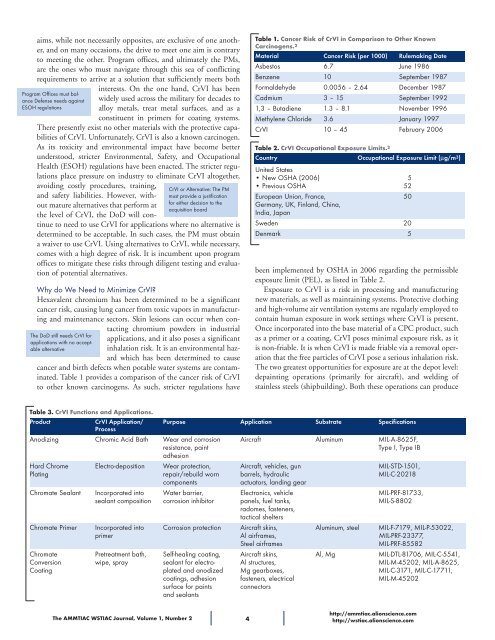AMMTIAC-WSTIAC Journal, Vol. 1, No. 2 - Advanced Materials ...
AMMTIAC-WSTIAC Journal, Vol. 1, No. 2 - Advanced Materials ...
AMMTIAC-WSTIAC Journal, Vol. 1, No. 2 - Advanced Materials ...
- No tags were found...
You also want an ePaper? Increase the reach of your titles
YUMPU automatically turns print PDFs into web optimized ePapers that Google loves.
aims, while not necessarily opposites, are exclusive of one another,and on many occasions, the drive to meet one aim is contraryto meeting the other. Program offices, and ultimately the PMs,are the ones who must navigate through this sea of conflictingrequirements to arrive at a solution that sufficiently meets bothinterests. On the one hand, CrVI has beenwidely used across the military for decades toalloy metals, treat metal surfaces, and as aconstituent in primers for coating systems.There presently exist no other materials with the protective capabilitiesof CrVI. Unfortunately, CrVI is also a known carcinogen.As its toxicity and environmental impact have become betterunderstood, stricter Environmental, Safety, and OccupationalHealth (ESOH) regulations have been enacted. The stricter regulationsplace pressure on industry to eliminate CrVI altogether,Program Offices must balanceDefense needs againstESOH regulationsavoiding costly procedures, training,and safety liabilities. However, withoutmature alternatives that perform atthe level of CrVI, the DoD will continueto need to use CrVI for applications where no alternative isdetermined to be acceptable. In such cases, the PM must obtaina waiver to use CrVI. Using alternatives to CrVI, while necessary,comes with a high degree of risk. It is incumbent upon programoffices to mitigate these risks through diligent testing and evaluationof potential alternatives.Why do We Need to Minimize CrVI?Hexavalent chromium has been determined to be a significantcancer risk, causing lung cancer from toxic vapors in manufacturingand maintenance sectors. Skin lesions can occur when contactingchromium powders in industrialapplications, and it also poses a significantinhalation risk. It is an environmental hazardwhich has been determined to causecancer and birth defects when potable water systems are contaminated.Table 1 provides a comparison of the cancer risk of CrVIto other known carcinogens. As such, stricter regulations haveThe DoD still needs CrVI forapplications with no acceptablealternativeCrVI or Alternative: The PMmust provide a justificationfor either decision to theacquisition boardTable 1. Cancer Risk of CrVI in Comparison to Other KnownCarcinogens. 2Material Cancer Risk (per 1000) Rulemaking DateAsbestos 6.7 June 1986Benzene 10 September 1987Formaldehyde 0.0056 – 2.64 December 1987Cadmium 3 – 15 September 19921,3 – Butadiene 1.3 – 8.1 <strong>No</strong>vember 1996Methylene Chloride 3.6 January 1997CrVI 10 – 45 February 2006Table 2. CrVI Occupational Exposure Limits. 2Country Occupational Exposure Limit (µg/m 3 )United States• New OSHA (2006) 5• Previous OSHA 52European Union, France, 50Germany, UK, Finland, China,India, JapanSweden 20Denmark 5been implemented by OSHA in 2006 regarding the permissibleexposure limit (PEL), as listed in Table 2.Exposure to CrVI is a risk in processing and manufacturingnew materials, as well as maintaining systems. Protective clothingand high-volume air ventilation systems are regularly employed tocontain human exposure in work settings where CrVI is present.Once incorporated into the base material of a CPC product, suchas a primer or a coating, CrVI poses minimal exposure risk, as itis non-friable. It is when CrVI is made friable via a removal operationthat the free particles of CrVI pose a serious inhalation risk.The two greatest opportunities for exposure are at the depot level:depainting operations (primarily for aircraft), and welding ofstainless steels (shipbuilding). Both these operations can produceTable 3. CrVI Functions and Applications.Product CrVI Application/ Purpose Application Substrate SpecificationsProcessAnodizing Chromic Acid Bath Wear and corrosion Aircraft Aluminum MIL-A-8625F,resistance, paintType I, Type IBadhesionHard Chrome Electro-deposition Wear protection, Aircraft, vehicles, gun MIL-STD-1501,Plating repair/rebuild worn barrels, hydraulic MIL-C-20218componentsactuators, landing gearChromate Sealant Incorporated into Water barrier, Electronics, vehicle MIL-PRF-81733,sealant composition corrosion inhibitor panels, fuel tanks, MIL-S-8802radomes, fasteners,tactical sheltersChromate Primer Incorporated into Corrosion protection Aircraft skins, Aluminum, steel MIL-F-7179, MIL-P-53022,primer Al airframes, MIL-PRF-23377,Steel airframesMIL-PRF-85582Chromate Pretreatment bath, Self-healing coating, Aircraft skins, Al, Mg MIL-DTL-81706, MIL-C-5541,Conversion wipe, spray sealant for electro- Al structures, MIL-M-45202, MIL-A-8625,Coating plated and anodized Mg gearboxes, MIL-C-3171, MIL-C-17711,coatings, adhesion fasteners, electrical MIL-M-45202surface for paintsand sealantsconnectorsThe <strong>AMMTIAC</strong> <strong>WSTIAC</strong> <strong>Journal</strong>, <strong>Vol</strong>ume 1, Number 2 4http://ammtiac.alionscience.comhttp://wstiac.alionscience.com
















